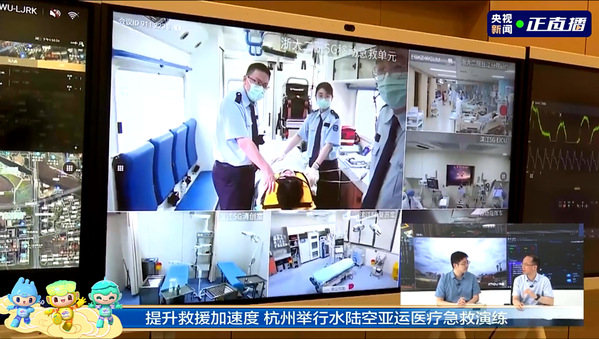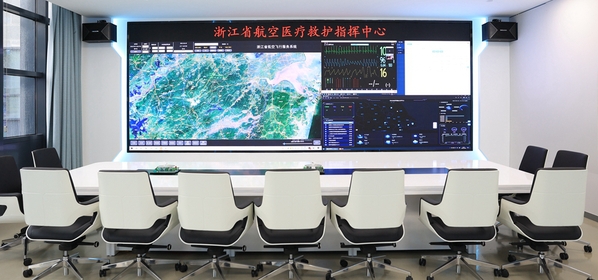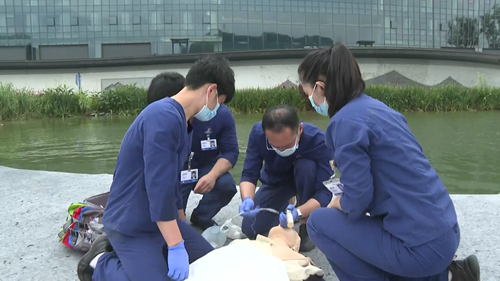Command center, a cycling mountain bike athlete just fell out of the track into a valley. Please provide aid.
There has just been a car collision on the road of south Hangzhou. A driver is trapped inside the car and bleeding.
Attention, search squad. A rowing athlete fell into the water near the finish line. Please conduct a search and rescue immediately.

Those were the words that kept sounding in the SAHZU Air Medical Services Command Center and 5G Remote Rescue Command Center on June 19. With these emergent calls from Chun’an, Fuchun River and urban area, a full-scale medical emergency exercise in air, water, and land scenarios for the upcoming Asian Games has kicked off.
This movie-like operation was conducted by the Second Affiliated Hospital Zhejiang University School of Medicine (SAHZU), the primary healthcare service provider of the Hangzhou Asian Games, in collaboration with other partners, including Hangzhou Asian Games Organizing Committee, city fire department and police department, Hangzhou Emergency Center, Ramunion Rescue Team, Red Cross Wolf Pack Rescue Team, China Zhejiang Police Aviation Team, Shengxiang Aviation, Shanghai New Sky Heli, and Zhejiang Low Altitude Flying Service. It is by far the most comprehensive emergency response exercise for the Hangzhou Asian Games.
This exercise tested systemic responses to simulated real-world accidents in complex environments such as mountains, urban roads and natural waters. Emergency rescue resources, such as air medical services, 5G mobile resuscitation units, UAV rescue network, were immediately mobilized to the accident sites under the command of Zhejiang Air Medical Center during the operation. The exercise showed that the whole emergency system worked closely together and responded quickly to ensure a safe Asian Games.

All real-time information including the location and routes of helicopters and the patient condition were displayed on the screen in the command center.
Air medical rescue: hospital in the air
When an athlete accidentally rushed out of the track in the Chun'an mountain biking site, a helicopter immediately came to rescue. A rescuer rappelled down from the helicopter to transport the patient. Once the patient was on the helicopter, he was already in a hospital in the air with all those 5G empowered digital tools.

Left: rescuer rappelling from helicopter; Middle: joint ground and air rescue; Patient's arrival at SAHZU Binjiang Campus
Urban road rescue: aerial drones for blood delivery
Hospital, police and fire department cooperated in urban road rescue scenario. SAHZU Mobile Resuscitation Unit, being a key part of the rescue efforts, gave its best performance in the exercise as always. Equipped with 5G remote ultrasound, VR teleconsultation and the aerial drones for blood delivery, the unit is truly a mobile hospital.

From left to right: China's first 5G mobile resuscitation unit; 5G empowered information system; patient blood sample delivered to the Hospital via vehicle-mounted aerial drone; blood product ready to be delivered back to the accident site
Open water rescue: efficient patient transport
In the scenario of unconscious rowing athlete fell into the water, the patient was saved by the rescuers on the life boat and transported very rapidly to the hospital after onsite medical care. The efficient prehospital and inhospital transportation ensured timely treatment for anyone in need.

Onsite medical care
SAHZU on wheels
A number of field equipment for medical rescue was unveiled on the same day too, providing strong support for the comprehensive and three-dimensional emergency rescue system.

Emergency communication vehicle, command vehicle, China’s first 5G mobile resuscitation unit, mobile CT vehicle, X-ray vehicle, rescue vehicle, cooking vehicle, power generation vehicle. When the whole fleet start on the move, it is the SAHZU on wheels.


The communication tent is equipped with 5G base station to guarantee the demand of emergency command and dispatch; the tent serving as mobile resuscitation unit and operating room could meet the aseptic criterial of trauma surgery; and there are other tents for mobile ICU unit, mobile laboratory, sterilization isolation and shower and rest. These tents make up a field hospital of SAHZU.
As the National Emergency Medical Rescue Center and the State-level Regional Center of Excellence of Trauma, SAHZU is the main hospital responsible for the healthcare services of the Asian Games and the referral center for air, water, and land emergencies.
It has built up a high-level emergency trauma treatment system and a high-capacity medical service network, fully prepared for the upcoming Asian Games.
Source:The Second Affiliated Hospital Zhejiang University School of Medicine (SAHZU)